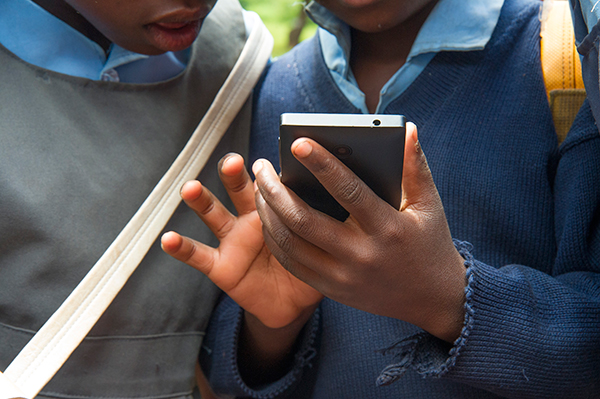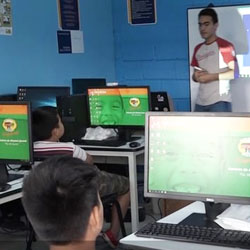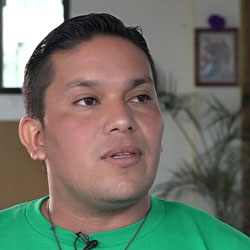
A human-centered design process is a critical step that is often overlooked when making important decisions in technology for development.
In the development space, funding usually comes from a donor or an agency, and the service or products it benefits goes to a different place, local communities in need around the world. The indirect link between the donors and the beneficiaries can lead to a lack of accountability—as Dave Algoso explains in his blog on Reboot.org.
But practicing human-centered design, or user-centered design, which puts the needs, wants and limitations of users first in each stage of the design process, can help ensure that the services and products actually meet the needs of the end users—the communities we seek to empower and serve.
For example, funding a software product that requires high bandwidth connectivity when the population it is meant to serve has minimal Internet connectivity will not benefit that community. Similarly, a mobile banking tool utilizing lots of text may not be appropriate for low-literacy communities.
Not practicing human-centered design could mean wasting funding on initiatives that simply aren’t effective and losing collaborative opportunities for designing better solutions.
At this year’s UXDC conference, organized by the DC Chapter of the User Experience Professionals Association, technologists, development practitioners and design professionals gathered to discuss “Lessons and Challenges in Implementing User Centered Design and UX Practices in the International Development Sector.” Human-centered design is gaining more and more traction in the international development realm.
Is international development ready for human-centered design?
International development funding mechanisms are mainly donor-driven, and convincing donors to invest in user research, user experience design or iterative prototyping (all important tenets of human-centered design) can be a tough sell. Funding models in development are not ideally set up for iteration, a key component for human-centered design.
Development funds are often taxpayer-funded and somewhat restricted in how they can be spent. Investing in a process that may require more upfront work and iteration may be considered wasteful.
The Request for Proposal process is set up in a way that assumes we have enough information to make decisions when pitching a proposal, and the turnaround timelines are very short. This is challenging for proposing and implementing technology innovations since it leaves little room for a human-centered design process, which requires more upfront thought, needs assessment and iteration.
To add to the hurdles, there is a lot of the confusion in the vocabulary between the user experience community and the development and humanitarian communities. The two groups speak different languages.
For example, humanitarian and development communities use terms like “access,” “capture,” “accountability,” “dignity” and “livelihoods.” User experience communities use terms such as “co-design,” “user-centered,” “journey mapping” and “need-finding.”
But there is room for finding common ground, if not a common language.
Some parts of the human-centered design process are already implemented (to some degree) in development but described and worded differently.
For example, the “capture” phase in development is when “need-finding” occurs in design. “Need-finding” is an essential part of human-centered design, where we understand the needs, limitations and concerns of the target users. The “capture” phase in development performs a similar task, but could be further enhanced by making the beneficiary more central to this research and make use of some of the design research method tools used in the human-centered design process.
Importance of participatory design
Despite the challenges, there are many opportunities to promote and improve on the use of human-centered design practices within development
For example, participatory design attempts to actively involve all stakeholders (e.g. employees, partners, customers, citizens, and end users) in the design process to help ensure the result meets their needs and is usable. This directly relates to the first principle of the Principles for Digital Development: “Design with the user.” A participatory design process builds collaboration across various internal teams that often work in silos: programs, technology, grants, procurement, and more.
However, “design with the user” isn’t always as easy.
Within development and humanitarian spaces, often the user or the person most affected could be a part of an extremely vulnerable group or hard to reach, and working directly with extremely vulnerable groups is not always possible or advised. In addition, funding restrictions may inhibit participatory design. For example, some U.S. government agencies won’t allow more than 10 external persons to participate in projects due to funding restrictions.
Also, there are multiple groups of stakeholders in development: community members, community leaders, development staff, development staff managers, donors, and more. Balancing and prioritizing needs is a challenge.
Bridging the development-user experience divide
There is a lack of understanding across user experience professionals and international development communities—a fact confirmed by panelists and participants at the UXDC session. But it is not an unbridgeable gap. More conversations and discussions around this topic are needed and panels, like the one at UXDC, help bridge this gap.
While there are many obstacles to implementing the entire human-centered design process and methods in international development projects, there are positive trends—including the emergence of development labs and innovation hubs with an emphasis on capacity building for teams and human-centered design training.
There also seems to be receptiveness and an eagerness among local innovators in developing countries to move forward with human-centered design.
For example, Creative Associates International worked in Honduras using a human-centered design approach, and performed research in partnership with the local field staff, to understand how the computer lab could better serve the wants and need of the community.
Creative trained the local Honduran staff and performed user interviews together, synthesized the results and brainstormed solutions together. Creative is now in the process of testing and iterating some of the proposed solutions. The team there is very positive and enthusiastic about this process, and they are leading it forward and are seeing how the work they are doing can make a big impact.
Caktus offers similar services to clients and recently conducted a discovery workshop in Turkey with a humanitarian NGO serving local refugee communities. The discovery workshop was conducted with roughly 15 client staff and utilized a series of brainstorming, mapping, outlining, crowdsourcing and voting activities to develop terms of success, user personas, journey maps and defined a minimum viable product.
Caktus has since been working with this client to co-design and iteratively build a custom web application that fits their unique needs.
Human-centered design principles are already being utilized in many development programs, but there are many more opportunities for improvement. Better metrics and further discussion and collaboration of human-centered design practice in development can help to address the challenges, demonstrate value and achieve lasting results in people’s lives.
Gina Assaf is a Product and User Experience Manager with the Technology for Development team at Creative Associates International. Tania Lee is a SMS & Web Product Strategist at Caktus Group. To read the Caktus Group blog, please visit. https://www.caktusgroup.com/blog/
For more information about the UXDC community or to join the human-centered design working group, please contact Gina Assaf, [email protected]; Tania Lee, [email protected]; or Ayan Kishore, [email protected].


